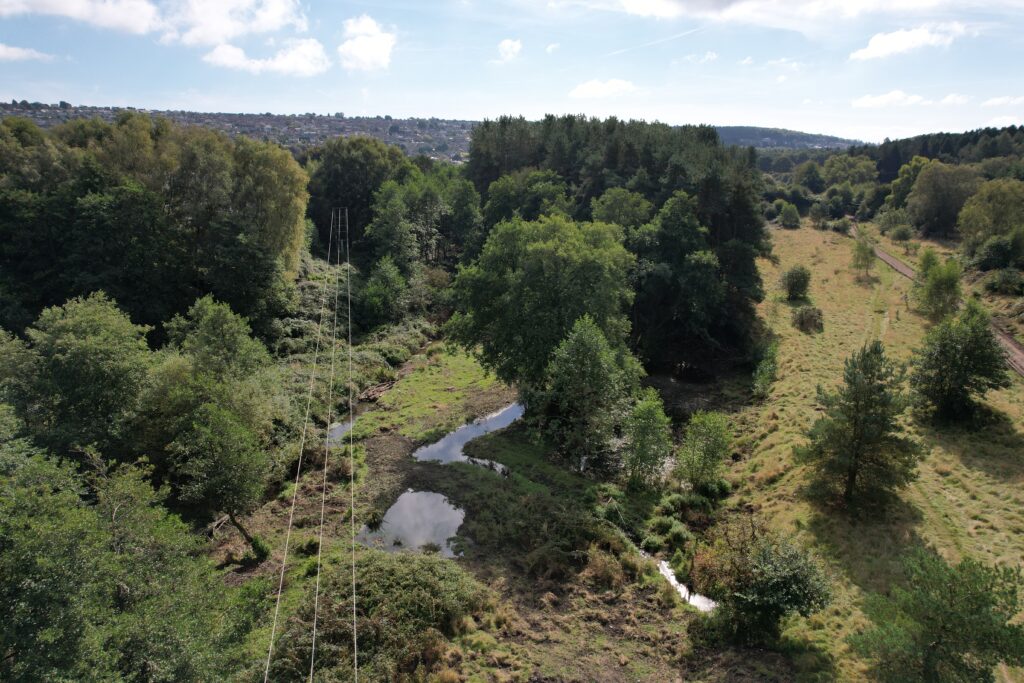Restoring Cinderford Brook
Severn Rivers Trust is delivering a major habitat restoration project on the Cinderford Brook, focusing on two key sites in the Forest of Dean: Linear Park and Blue Rock Trail. This long-term initiative is designed to improve river health, restore wildlife habitats and boost water resilience in the face of climate change.
The Cinderford Brook, like many rivers in the region, suffers from low summer flows, limited habitat diversity and historic modifications that restrict fish movement. To address these issues, we’ve been restoring natural processes through wetland creation, the introduction of Large Woody Debris (LWD) and the reconnection of paleo-channels. These interventions slow the flow of water, improve fish passage and create new, varied habitat for aquatic life.
Improving fish passage and channel diversity
One of the main goals of the project is to help migratory fish such as Atlantic salmon, eel and brown trout reach their spawning grounds. At Blue Rock Trail, we’ve placed over 1,300 tonnes of local stone into the brook, creating new riffles and slowing water velocities in previously over-engineered sections. This helps drown out physical barriers like weirs and perched culverts, allowing fish to swim upstream more easily.
Linear Park has also seen major changes, including the removal of man-made obstacles and the addition of woody material to encourage natural channel formation. The work is already benefiting fish and invertebrate populations by creating more complex flows and habitat niches.
Across both sites we have:
-
Added over 2,500 tonnes of stone
-
Installed over 75 Large Woody Material features
-
Built 13 in-channel hazel berms
-
Enhanced over 3 km of river habitat
Restoring natural flows and building climate resilience
By reconnecting historic floodplains and installing features like boulders, LWD, wetlands and hazel berms, the Cinderford Brook can now hold more water in the landscape for longer. This slows runoff, stores water during dry spells and reduces local flood risk, supporting both people and wildlife.
This work has also created new and diverse habitat for fish and invertebrates.
-
Linear Park: 1.02 km restored with LWD and bank regrading
-
Linear Park: 0.15 km enhanced through new riffles
-
Linear Park: 1.2 km improved through in-channel hazel berms and an overflow channel into wet woodland
-
Blue Rock Trail: 0.81 km transformed through the addition of around 1,300 tonnes of local stone
Water retained in the wetlands and reconnected floodplain soils now drains slowly back into the brook, helping to maintain flow in dry weather and improving resilience to climate extremes.
Improving fish passage and connectivity
We’ve also addressed barriers to fish migration:
-
Linear Park: Two barriers mitigated – removal of one sheet-metal plate and drowning out of a perched culvert through a new rock riffle
-
Blue Rock Trail: One 0.3 m weir drowned out through a new rock riffle
-
Across both sites, added stone and woody material have increased channel roughness and diversity, slowing the flow and allowing fish to move freely upstream
A community-centred approach
We’re proud that local residents have embraced the changes. One nearby walker said:
“We live in Soudley at the end of the Blue Rock Trail and walk the trail daily. The brook has been transformed into a lovely babbling stream. The new work has really improved access and wildlife habitat.”
— Jan Ellis, Soudley
We want more people to get involved. You can help monitor the brook’s progress by visiting the walking trails in Linear Park and snapping photos with your smartphone. These fixed-point images help us track how the river and surrounding landscape are changing over time.
Project partners and support
This project is funded through Severn Trent’s WINEP programme and the Environment Agency’s WEIF programme, with support from Forestry England (landowner) and the Severn Vale CaBA partnership.
We’ll continue this vital river restoration work in the coming years, improving habitat, supporting wildlife and building climate resilience in the Forest of Dean.






